Introduction
The most egregious fiction about Ancient Egypt (AE) is the assertion that a Stone Age culture quarried and transported tens of millions of TONS of stone, mud brick and other material to build their monuments. Egypt does not have the remains of infrastructure for accomplishing this feat. Rome has the Via Appia, fig.1A, but Egypt does not have infrastructure for moving this amount of material. Perceptions today are framed by the pre-10,000 BC narrative where everyone was a spear-thrower. This nonsense is sustained by the deeply embedded cultural notion that technological development is time dependent. In other words, the further back in time one goes the more primitive technology becomes.
Quarries in Egypt contradict this notion. The most difficult point to accept is the assertion that in the past plasma technology was exploited by man. Edward Leeskalnin proved it could be readily harnessed. Michael T. Wright demonstrated analog computer technology was known in the ancient past, which enabled the AnE to craft with modern precision the iconic Egyptian statues documented by Chris Dunn1. Quarry research is so focused on trivial points, little is worth quoting. Research ignores how tens of millions of tons of material was extracted, transported, and used. What has been done is to continually attribute the impossible to the incapable.
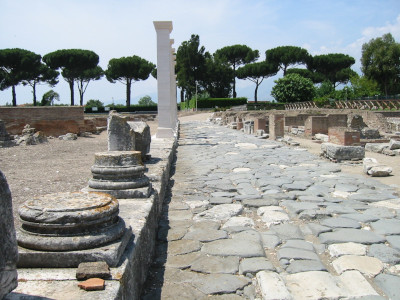

Figure 1
The eight columns on the front of the Pantheon in Rome are presented as Roman craftsmanship (Wikipedia). However, the only Roman involvement was removing them from Egypt. Seven of the eight columns came from the Egyptian quarry of Mons Claudianus and the other from Aswan. Neither Romans nor Ancient Egyptians (AE) could manufacture and transport seven 60+ ton columns 62 miles to the Nile; gravity forbade it. If Romans were capable of quarrying them, all would have come from the same quarry. Emperor Hadrian, the builder, did what Rome had frequently done, resort to plunder. Two separate Egyptian temples located close to the Nile provided columns. The emperor, who traveled through Egypt, probably saw temples with similar columns. The only challenge faced by the Romans was moving them from temple to Nile and Tiber to Pantheon, the later distance was 700m. These columns are rather small in comparison to what is found at Mons Claudianus.
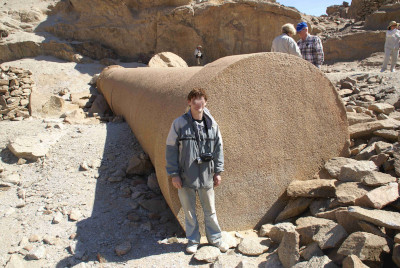
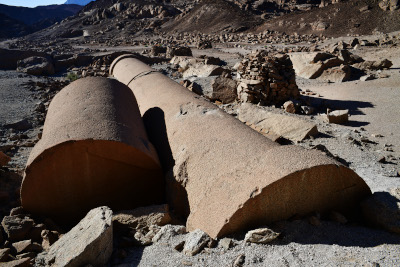
Figure 2
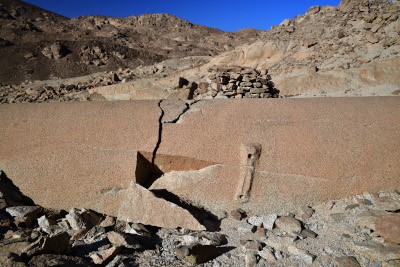
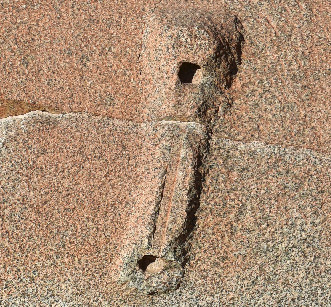

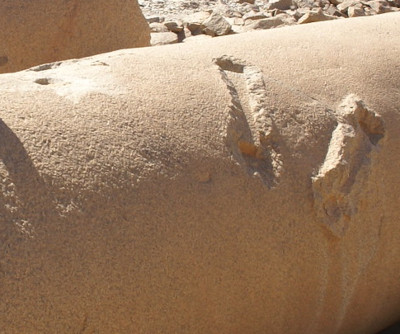
Figure 3: Examples of repair attempts on column. AE could not do this.
At this quarry 200+ ton columns were manufactured, fig.2a. If mechanical means were involved in fabrication, one would expect to find remains of supporting infrastructure. What is seen in images is flimsy free stone construction. Work was still in progress when column, fig.2b, broke towards the far end. Six or more repair attempts were made on minor fractures; they can be seen in fig.3. The holes (top-right) were not round but hexagonal. The fractures indicate these columns were somewhat fragile. The repairs implied confidence in being able to move the fractured 200+ ton monolithic column safely from Mons Claudianus to a construction site, and erect it. Like all monumental structures in Egypt, these columns imply technical skills far beyond what AE and Romans could command. The people who transported them were the Antecedent Egyptians (AnE). Crafting, transporting and erecting columns of this size could only be accomplished utilizing the levitating property of plasma.
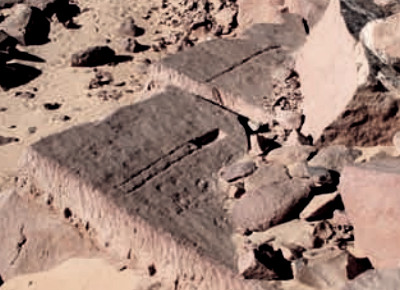
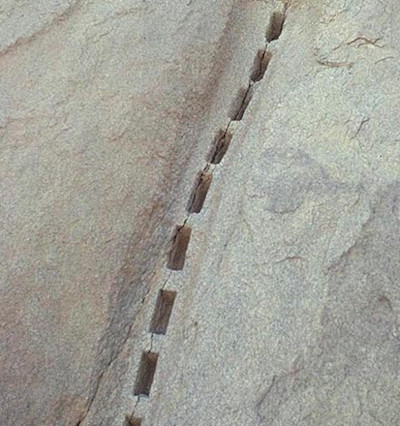
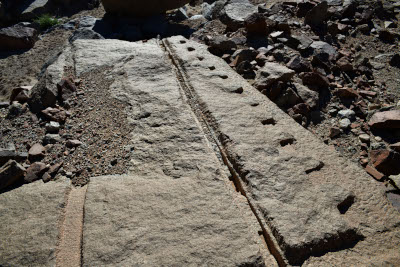
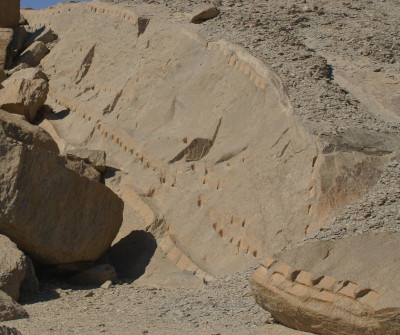
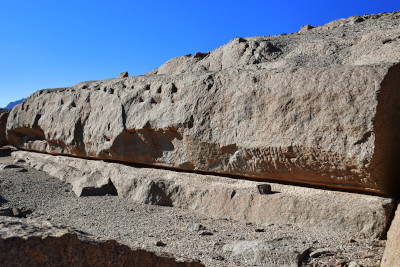

Figure 4: Methods used to shaping rock.
Two ways were used to separate a block from bedrock. A device that perforated rock which will be covered below and a device using wedges, fig.4c, for bulk removal of rock. To shape large blocks, a channel was first outlined with plasma beam then the intervening rock broken out, fig.4a. Then a series of wedge shaped cavities cut into the channel. A device with wedges was set in the channel in order to send a powerful shock into rock along the channel's plane to make a fracture. The channel and wedges running along the edge in fig.4c was used to cleave the top off the rock. A crack can be seen running the length of wedges in fig.4b. The breaks were fairly clean, fig.4c-d-f. If the amount of rock to be removed was not so great, a channel was not needed, fig.4f. Wedges performed the macro adjustments, but technology for doing this is unknown.
Plasma gave craftsmen a controllable method of shaping rock. This is evident in fig.4f. The collar was added to the column by removing softened rock. Height of the collar indicates the workers could control the depth plasma had on softening the rock. As Sir Petrie noted regarding incised hieroglyphs, 'they are not scraped nor ground out, but are ploughed through the diorite'2. This description could only describe softened rock. The earlier example of a statue with a hand graved nemes could only have been done if the rock was softened. These examples are not the work of a Stone Age culture but one using advanced technology.
Tourists are wowed by the column in fig.2,3 but researchers appear not to be. They will spend weeks mucking around ruins of a nearby Roman fort for whatever, but no one has ever bothered to excavate the column. Otherwise, it would not be choked with debris. It is a repeat of the Giza Pyramids masons' waste. Sir Petrie said all the construction debris from building of the pyramids was dumped over the edge of the Giza plateau. He estimated it represented half the GP pyramid's volume.3 Organic evidence found would invite C14 dating which is not done in Egypt. Dates are derived only by reference. This imprecision spawns cockroach and soap opera science.

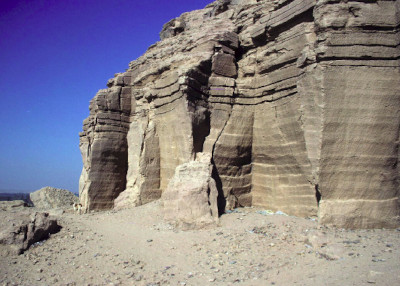
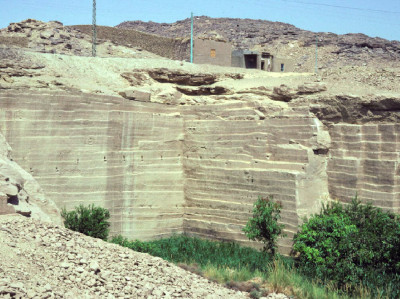
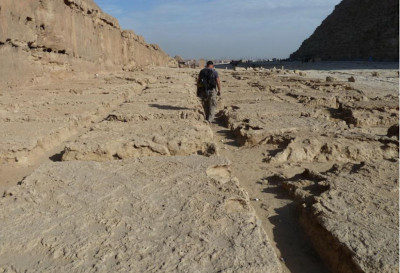
Figure 5: A few of the many quarries in Egypt.
The images above should give the reader an idea of the enormous scale of quarry work in Egypt. Researchers use the term 'industrial' to describe the dimension of this work. There are many more quarries.4 Researchers can not find any roads that show evidence of heavy usage exiting quarries. The material for brick manufacture had also to be transported. Researchers would assert this scale of quarrying was done by a Stone Age culture using stoop-labor. Furthermore, most of the quarried rock is missing5. As much as they try, the AE narrative can never be animated. It is nothing but a litany of literary contrivances created by soap opera science.
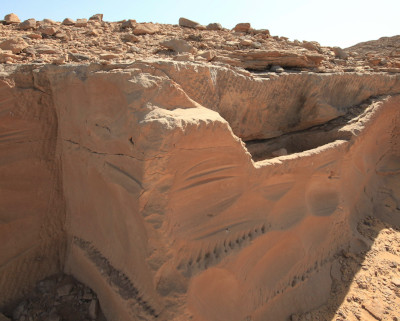
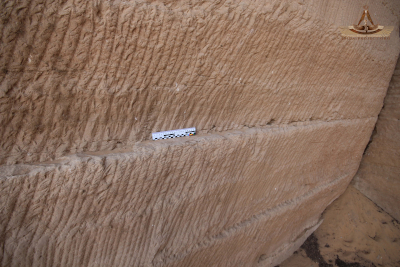
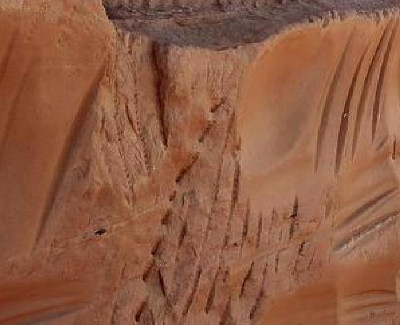
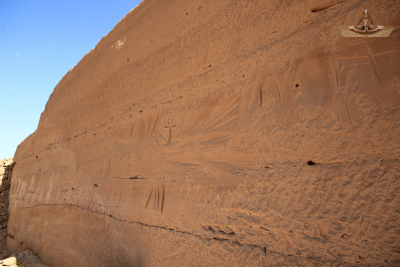
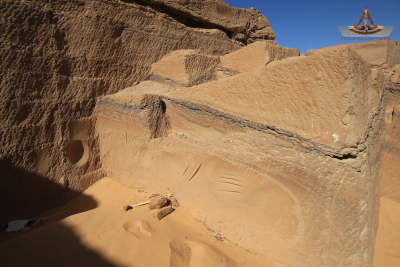
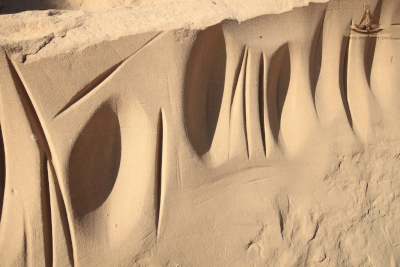
Figure 6: Examples of plasma use at Silsila Quarry.
A closer look at evidence of plasma use at Silsila Quarry is instructive. The pounder nonsense does not work at Silsila. Science has no explanation for how diagonals, depressions, hemispheres, channels and polish in fig.6 were created. Their steadiness implies the device making projector impressions was light, easily manipulated with instant effect. The length of channels is more or less the same. This indicates the amount of power available came in small bursts with the rock responding instantaneously to the plasma. All channels and depressions are sharply defined. No evidence of unsteadiness at edges implied the workers were skilled with use of the machines. Diagonal pattern covering walls are remains of extraction perforations, fig.6b. Running horizontally, they only vary in length with each course. The variation in thickness shows depth of penetration was controlled rendering blocks of different sizes. Courses lack any apparent breaks so appear to have been removed in their entirety and cut into blocks elsewhere. A worker carefully avoided destroying the ankh in fig.6d. The glyph is another indication Egyptian writing existed prior to the PC. The vast majority of plasma impressions at Silsila are close to the ground. This might indicate the work pace slowed, and workers had more unproductive time. The slowdown may have resulted from political turmoil among the AnE.
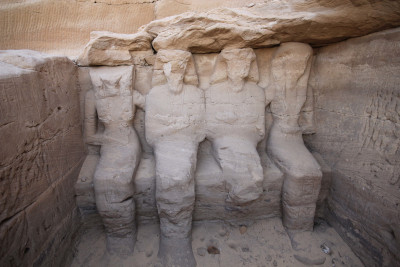
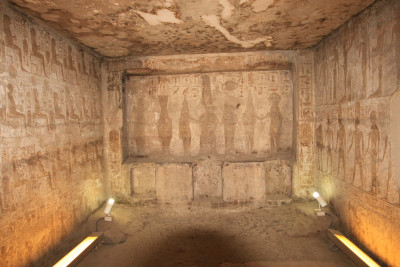
Figure 7: Females are embracing the males which is an AnE pose making these images over 10kyo.
Around Silsila Quarry are a number of carvings like those in fig.7. Since females embrace the males, they were created by AnE . It appears political turmoil occurred in AnE society. Someone effaced both (7a,b) with a hammer and then used a plasma projector on their bodies to erase them. They were 'rubbed out' which dates the destruction to pre-PC period. Associated with these statues was hieroglyphic text. On either side are sections of text hacked out. The damage can be seen on left and right side of the image (7a). The destruction in (7b) is carefully limited to the figures. Apparently a political struggle occurred among the AnE. The damage is evident their technology was still functioning if the turmoil was precipitated by early appearance of the Z-pinch Aurora (ZPA).
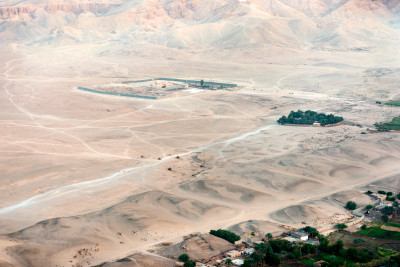
Figure 8: Photo: flickr kairoinfo4u; Enormous piles of extracted dirt on the west side of the L. Birket.
The Flickr account 'kairoinfo4u' posted the above image of enormous piles of dirt extracted from Lake Birket. He states, the piles extend for nearly three kilometers. AE did not construct them. The precise layout is typical of the AnE. These piles are another example of their advanced technical skills that did not depend on stoop-labor. The orderly layout of the piles implies some type of mechanized conveyor system. American Indians constructed Mound 'A' at Poverty Point, Louisiana by dumping baskets of soil to form the hill. Complete basket dumps were found in the soil profile. If these piles were excavated it might be possible to determine the type of conveyor system used. Using such a mechanical system at L. Birket could explain how blocks were moved from quarry to construction site. The image also raises questions about where and how AnE generated power for such industrial operations. A Stone Age culture did not raise these mounds using stoop-labor.
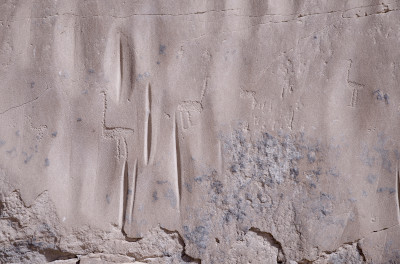
Figure 9: Photo:flickr, kairoinfo4u; Ostriches on the walls of Silsila, the wildlife took over.
Another image posted by 'kairoinfo4u' is as informative as the previous. Above is an image from Silsila Quarry. The rock was polished by a plasma projector, but channels and depressions are still apparent. Later someone pecked out images of ostriches. No doubt the birds were passing through Silsila in route to the river for water. While Silsila was a hive of activity, these birds were absent. This is strong evidence Silsila was abandoned, and wildlife took over. The area became a hunting ground. The AnE were gone, destroyed by the PC. Those that survived were reduced to hunters pecking out petroglyphs. There could have been a thousand years between when the projector polished the wall, and the ostrich was pecked out. Both human and animal populations had to recover from the disaster. The portion of AnE culture that survived, religion and writing, withdrew to other areas of the Nile Valley. For survivors, it was back to the Stone Age. The ostrich petroglyphs contain an ominous warning. As George Santayana said in effect, those who do not learn from history, are doomed to repeat it.
The assertion that a Stone Age people using stoop-labor moved tens of millions of tons a material is nonsense. AE were simply a Stone Age culture who inherited the shattered remains of their ancestors. Enough of the AnE cultural achievements remain to determine what occurred. Either their technology was wiped out or their population was so devastated maintenance was no longer possible. Sardinians bequeathed detailed images of what forces drove AnE culture to extinction. Even a so-called minor appearance would reek havoc on our metallic world. Plasma is fundamental to earth's evolution. Suppression of plasma science subverts the very discipline needed to confront and ameliorate the z-pinches. This science is vital for the nation's security. The choice is either face reality or face Götterdämmerung. Solutions will not emerge from soap opera and cockroach science. These contrivances are nothing but shamanism.
Edward Leeskalnin built the coral castle with five ton blocks of coral; Michael T, Wright crafted a working model of the Antikythera Mechanism, an analog computer; Chris Dunn documented the precision crafting of the iconic Egyptian Statues.↩︎
The Pyramids And Temples of Gizah, W M Flinders Petrie, p 75↩︎
Ibid, p 85↩︎
For a list see: Ancient Egyptian quarries – an illustrated overview, James A. Harrell and Per Storemyr, Geological Survey of Norway Special Publication nr. 12, 2005↩︎
The building stones of ancient Egypt – a gift of its geology, Dietrich D. Klemm, Rosemarie Klemm, African Earth Sciences 33 (2001) 631–642↩︎

